One year has passed since I acquired Where To? from tap tap tap. Time to ask myself: was it all worth it? But first of of all, some background: Where To? was one of the first ~500 apps when the App Store launched in July 2008. The sales numbers where really impressive in these gold rush days of the App Store. When the app was put on the acquisition market it was removed from sale in the App Store for about two months. Two months in the iPhone app market is an eternity. Time for new competitors (and copy cats) to enter the stage. And time for customers to forget about your app and look for alternatives. So we expected way lower monthly sales. Basically, we had to start from scratch in terms of ranking and reputation.
Also, many apps in the store show a peak behavior with an initial spike and a following irresistible decrease in sales. In some cases apps started a second life at a lower price point (typical for many games, but also for apps like Beejive). We always hoped that Where To? would rather achieve sustained success allowing to develop new functionality on an ongoing basis. Also, this was a key factor in my plan to amortize the investment in 18 months.
It turns out, Where To? is not the kind of rocket-like app that flies through the roof and then crashes on the hard surface of negligible sales. Since the takeover in mid December 2008, it made a total of $325.055,07 in gross sales, that’s $227.538,55 after Apple’s cut:
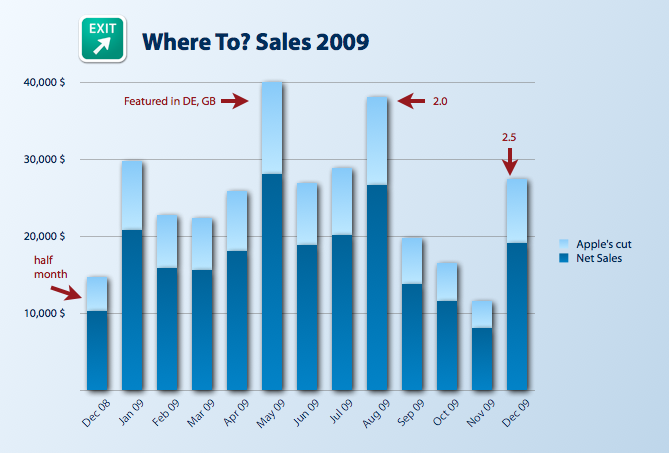
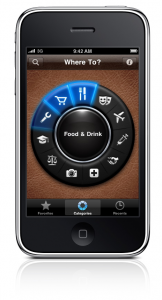
 Where To?
Where To?
- What is it: find points of interest around you
- Price: $2.99
- Gross sales: $325.055,07
- Net Sales: $227.538,55
- More Info: at the App Store
Marketing
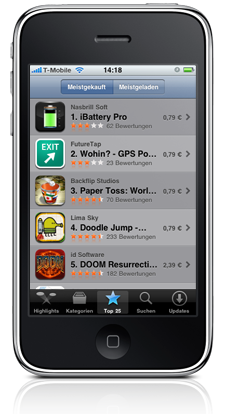 Admittedly, there is a large volatility caused by factors such as new versions, featuring by Apple and advertising. Speaking of advertising, we experimented with all kinds of different media and types. While in the first half of the year we had decent success with cost-per-click campaigns such as Google Adwords, in the recent past virtually all sorts of paid advertising were totally ineffective (with Admob and Facebook offering the worst value in terms of ad dollars spent per sale). The root of the problem is that at a sale price of $2.99 ($2.10 after Apple’s cut) and typical click-to-sale conversion rates of 5-10% the maximum affordable CPC is at around 10-15¢. For apps priced lower than $2.99 or promotional offers the maximum CPC is even less. At this level, however, the available inventory is nearly non-existant. This is the reason we drastically reduced our ad spending since September. Overall we spent roughly $50k in ads so far which is far lower than initially planned.
Admittedly, there is a large volatility caused by factors such as new versions, featuring by Apple and advertising. Speaking of advertising, we experimented with all kinds of different media and types. While in the first half of the year we had decent success with cost-per-click campaigns such as Google Adwords, in the recent past virtually all sorts of paid advertising were totally ineffective (with Admob and Facebook offering the worst value in terms of ad dollars spent per sale). The root of the problem is that at a sale price of $2.99 ($2.10 after Apple’s cut) and typical click-to-sale conversion rates of 5-10% the maximum affordable CPC is at around 10-15¢. For apps priced lower than $2.99 or promotional offers the maximum CPC is even less. At this level, however, the available inventory is nearly non-existant. This is the reason we drastically reduced our ad spending since September. Overall we spent roughly $50k in ads so far which is far lower than initially planned.
I feel the most effective marketing are continued improvement, word of mouth and of course positive reviews both in the App Store (yes, you’re welcome to take this as friendly reminder to review Where To? and all your favorite apps you use everyday 😉 – Thanks!) and in the press (e.g. TUAW or iPhoneFootprint). After releasing new versions, Where To? achieved rankings in the top 50 of all paid apps in the US, #2 in Germany and it climbed up to the top position in the Navigation category in the US, Germany and other countries. Clearly, this strategy wasn’t too bad.
Going International
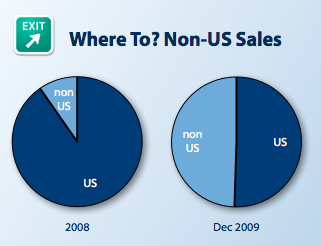 Another interesting subject is our internationalization strategy. In contrast to other app genres local search is highly dependent on a good adoption of the local language. So localization has a completely different importance in our case. Throughout the year we added localizations for all major iPhone markets. Including our recent Japanese localization, Where To? is now localized into 9 different languages and contains local categories and brands. This contributed to a noticeable increase in non-US sales: Before the acquisition the US accounted for 90% of the sales, in December ’09 the non-US share increased to almost 50%.
Another interesting subject is our internationalization strategy. In contrast to other app genres local search is highly dependent on a good adoption of the local language. So localization has a completely different importance in our case. Throughout the year we added localizations for all major iPhone markets. Including our recent Japanese localization, Where To? is now localized into 9 different languages and contains local categories and brands. This contributed to a noticeable increase in non-US sales: Before the acquisition the US accounted for 90% of the sales, in December ’09 the non-US share increased to almost 50%.
A Worthwile Investment?
So was it all worth it? – Yes, absolutely. While the bottom line of our sales was lower than expected, the profit turned out better than planned due to the lower than budgeted ad spending. So there’s a good chance my $70k investment will pay off sooner than expected. In terms of the make-or-buy decision, I think I made the right decision. Although meanwhile, the acquired code only contributes to a small percentage of the whole code, the (unchanged) basic look-and-feel and the market reputation of the app are critical success factors. Also, my point of time-to-market being a key factor now holds true more than ever. With more than 100,000 apps in the store, every day a new potential competitor enters the market and it’s important to be first.
What would I do differently today? – Well, I’ve learned the hard way that the transfer of an app into a different iTunes vendor account is practically not possible. Should I acquire an app again, I’d avoid the disaster and do the account switch right away.
Despite all the trouble we had with Apple last year, we’re absolutely thrilled how the App Store ecosystem grew in the last 18 months and what amazing potential it offered to developers. We’re more than happy with our outcome and take it as an incentive to achieve even more in 2010!
The Future
We always said that new apps are being planned. Unfortunately we didn’t deliver on that promise so far. We sincerely hope to change this the sooner the better. (If you happen to be a talented Cocoa developer anxious to get your hands at some interesting new projects, please get in touch.) Also, we do have a great roadmap for updates of Where To?, so I’m happy to welcome year 2 in the history of FutureTap!
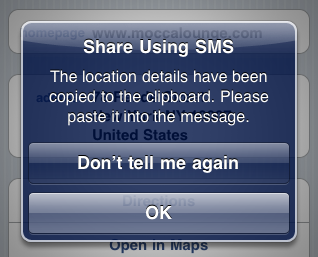 Our last Where To? update was the first update to go through Apple’s automated private API usage detector Craig Hockenberry noticed recently. No wonder, this tool found one match we introduced four updates ago and falsely didn’t consider as a problem. The method is named setNumberOfRows: and allows placing two buttons in an alert below each other instead of beside each other.
Our last Where To? update was the first update to go through Apple’s automated private API usage detector Craig Hockenberry noticed recently. No wonder, this tool found one match we introduced four updates ago and falsely didn’t consider as a problem. The method is named setNumberOfRows: and allows placing two buttons in an alert below each other instead of beside each other.
What was interesting though: Apple didn’t reject the update but just asked to resolve the issue at the next update. To me that’s a new spin to the whole App Store review debate and I must admit that I like the approach. Still, it’s debatable why such a useful functionality to create alert buttons with slightly longer labels is a private API. But leaving that aside I value Apple’s approach to solve those kind of minor issues in a low-key manner that doesn’t lead to silly resubmissions and loosing valuable time.
After all, it’s in Apple’s best interest to avoid burdening the review team the loads of resubmissions by giving the developer the time to fix the issue at the next update.
Today, we finally transferred Where To? to our own iTunes account. From now on, the vendor name is not incorrectly stated as “Sophiestication Software” anymore. After more than 6 months of waiting for Apple (and after numerous discussions with various Apple folks) to resolve the issue of transferring an iPhone App in the App Store, we finally resorted to publishing Where To as a new app under our account and removing it from sale of Sophia’s account. This procedure unfortunately causes the purchaser history to be lost since Apple does not provide any buyer details to us.
Why not wait until the next version?
Good question. Obviously it would make perfect sense to wait with the transfer until the upcoming Where To 2.0 with exciting new functionality is out. Unfortunately, this was not an option because our contract with Sophia to use her iTunes vendor account expires by end of this month. Sophia was not willing to negotiate the expiration date. So we are in a position of either killing Where To completely or doing this. Clearly, this isn’t the way I prefer to do things because it’s against my understanding of respecting customers, but I simply had no choice in this situation, unfortunately.
What does this mean for me as a (potential) new customer?
New customers who purchase Where To from now on will automatically be eligible for a free upgrade to the upcoming Where To 2.0. Think of it as a grace period for a free upgrade that begins now.
What does this mean for me as an existing customer?
First, the existing version of Where To in the FutureTap account is exactly the same as the version in the “Sophiestication Software” account.
Second, we are working to offer a price-reduced upgrade path to version 2.0 for current Where To owners who purchased it from the seller tap tap tap or Sophiestication Software.
While we know this is surprising and nasty for you, we had to take this unevitable step at some time although we delayed it as much as possible. So depending on your purchase date, you received a whole lot of updates for free. Only the next major version will be a paid upgrade. Please subscribe to this blog and/or follow us on Twitter to stay informed.
You mentioned Where To 2.0. Will it be cool?
Absolutely! We integrated a ton of new features in Where To 2.0. Most requested, the map will be built-in leveraging iPhone OS 3.0. Switching apps is no longer necessary. Then, the results automatically update while moving. Overall we think it’ll be an amazing update that you’ll absolutely love! Follow us on Twitter to watch some sneak peeks from our labs soon and to be the 1st to know when it’s available!
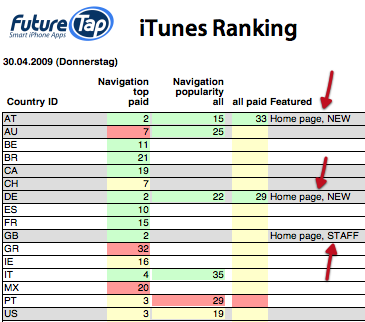 Many iPhone developers are monitoring their app’s ranking and reviews. There are some tools to automatically retrieve the ranking (MajicRank) and the reviews (Erica Sadun’s perl script) for all country-specific App Stores using web scraping.
Many iPhone developers are monitoring their app’s ranking and reviews. There are some tools to automatically retrieve the ranking (MajicRank) and the reviews (Erica Sadun’s perl script) for all country-specific App Stores using web scraping.
What is missing so far is a solution to retrieve information about feature entries on the App Store start page such as “New and noteworthy”, “What’s hot” and “Staff favorites”. Mentions on the start page have a considerable influence on sales. To avoid monitoring the different country-specific stores manually in iTunes, I wrote a Perl script that can be scheduled to run daily. The script is launched with the app’s iTunes ID (the numeric ID at the end of the iTunes URL you can copy in iTunes using right click on your app title) as a parameter and puts out the current date, country and the type of the mention:
./iTunesFeatured.pl 314785156 Navigation
09.08.2011 AE App Store: Home page, Staff Favourites Navigation: Home p…
09.08.2011 AR App Store: Home page, Staff Favourites Navigation: Home p…
09.08.2011 AT App Store: TOP STAGE, Home page Navigation: Home page
The script takes a while to complete because it needs to fetch 8 9 pages per country. The output is in tab-delimited format to facilitate post processing of the data. In our case, we’re importing the data into a FileMaker database that allows an easy graphic representation (colors to indicate trends) and the creation of all kinds of reports.
So, let’s get to the meat: The script is available on http://github.com/futuretap/iTunesFeaturedCheck.
Do you find this useful? I’d love to know your feedback in the comments or via Twitter!
Update 23.11.2009: Modified to work with iTunes 9 App Store
Update 30.12.2009: Modified Japanese match term for New and Noteworthy
Update 29.07.2010: Implemented check for category level featuring, posted on
GitHub
Update 01.09.2010: Added iPad support (thanks to
@the_appmaker), adopted script to a small iTunes server change
Update 02.12.2010: Adopted script to a small iTunes server change (thanks to
@triplef)
Update 15.04.2011: Adopted script to an iTunes server change; now fetches compressed data to save bandwidth; added Games subcategories
Update 09.08.2011: Now also fetches arbitrary featuring categories on the App Store homepage, including App Of The Week
Update 09.07.2012: Revised version with multi threading
 It’s been a few weeks since my last post, and I wanted to let you know that in that time, “Where To?” has been evolving into becoming more of a FutureTap title. A couple days ago, we released the 1.6 update. This new update adds “Shake for Surprise” and on-the-fly translation among some minor improvements. These were done with the help of Sophia, who I think has done a really incredible job with this update. Details of why the original creator of the app is still working on it, after it had been sold to FutureTap, are here.
It’s been a few weeks since my last post, and I wanted to let you know that in that time, “Where To?” has been evolving into becoming more of a FutureTap title. A couple days ago, we released the 1.6 update. This new update adds “Shake for Surprise” and on-the-fly translation among some minor improvements. These were done with the help of Sophia, who I think has done a really incredible job with this update. Details of why the original creator of the app is still working on it, after it had been sold to FutureTap, are here.
However, the update isn’t the only thing that is new. We’ve also been encountering something strange in the App Store, which should serve as a warning to anyone else needing to transfer an App from one developer account in iTunes to another. Apparently, the idea that ownership of an app, including it’s list of customers (to receive free updates) can change, never occurred to the creators of iTunes or the App Store. It seems that transferring ownership of an App is extremely difficult, if not impossible, to do in the App Store. As a result, Where To is still listed as being sold by tap tap tap Sophiestication Software (see update below).
This situation has created a ton of headaches for us. On one hand, it can cause confusion for potential buyers, who may search for the App under the FutureTap brand. For the developer, it means that the creation of new Where To releases always requires special steps for Sophia to take, such as signing with her certificate. Sophia has been extremely accommodating in helping us for whatever we ask, but the inconvenience and hassle seems so unnecessary. Our change request with the Apple iTunes team is now exactly 2 months old. We’ve been told that it will be resolved soon. (Still) keeping my fingers crossed!
Update on May, 20: The situation is pretty much unchanged. Only the seller name is indicated as “Sophiestication Software” for some time now. Sophia finally managed to change the name to her company name after the split of tap tap tap.
Update on June, 23: We resorted to pull the app from the old account and publish it as a new one. See “Transferring an iPhone app: last episode” for details.
 When I first came across tap tap tap’s Where To sale offer, I was fascinated and scared as well. Fascinated because it would offer a jump start in the App Store; scared because of the risk involved. And puzzled about all the questions on how to do such a deal: What would be a reasonable price? Can such a transaction really work? — I’ll try to give some answers here.
When I first came across tap tap tap’s Where To sale offer, I was fascinated and scared as well. Fascinated because it would offer a jump start in the App Store; scared because of the risk involved. And puzzled about all the questions on how to do such a deal: What would be a reasonable price? Can such a transaction really work? — I’ll try to give some answers here.
Why buy an app?
Having strong developer roots, I admit that my first thought was: OK, this app really looks nice but why don’t you develop a similar one on your own? Shouldn’t be that hard. However, my experience at equinux, my former company, taught me that a) most development takes longer than anticipated and b) time-to-market is critical – especially in light of the xmas shopping season.
A second reason in this particular case: Where To is not just a bunch of Objective-C files. It’s a brand that’s well-established in the market and it comes with a really outstanding UI. So buying rather than making-yourself seemed like a good option.
How to value?
This is tough. There is not really any experience how to value an iPhone app. If you offer too much, you’ll never get your return on investment (ROI). If you offer too little, someone else gets the deal.
Sidenote
As a historical analogy we all witnessed the same inexperience of how to price an iPhone app for the consumer. What is a fair price that still allows the makers a living? Unfortunately both questions are tied together since a future change in the consumer pricing would strongly affect the app’s ROI and valuation.
 Furthermore, I’m not an investment shark whose daily business is valuing products and companies. So I had to come up with my own ways of evaluating Where To’s value. One traditional model for company valuations is the discounted cash flow (DCF) method where you basically sum up future earnings indefinitely. Future earnings are discounted with an interest rate that takes into account various factors such as the risk and the cost of capital. The problem is that this method heavily relies on reliable forecasts. We didn’t have such forecasts, mainly because the whole App Store market is so fast-paced and on the other hand still in its infancy. So it’s hard to predict even roughly where the whole thing’s heading.
Furthermore, I’m not an investment shark whose daily business is valuing products and companies. So I had to come up with my own ways of evaluating Where To’s value. One traditional model for company valuations is the discounted cash flow (DCF) method where you basically sum up future earnings indefinitely. Future earnings are discounted with an interest rate that takes into account various factors such as the risk and the cost of capital. The problem is that this method heavily relies on reliable forecasts. We didn’t have such forecasts, mainly because the whole App Store market is so fast-paced and on the other hand still in its infancy. So it’s hard to predict even roughly where the whole thing’s heading.
I came up to choose the technique of using EBIT multiples. Of course, I didn’t buy a company but only a product. So I needed to calculate a virtual “product EBIT” first. Given the published numbers and estimated costs for development, marketing, support and various other operating costs, I estimated a yearly EBIT of $45,000-50,000.
My offer
We agreed on my initial offer of $70,000, where a portion of the whole transaction volume goes into services such as training and the development of new features.
This results in a multiple of 1.5 — pretty small at first sight compared to multiples of 52 for Skype and 27 for MySpace (see this summary). However, there are some important differences:
- Where To is not (yet 😉 ) as big as Skype or MySpace
- The acquisition is just about a product and no staff
- as stated before the iPhone market is still immature and future sales unreliable
- the whole thing lives off the marketing effort which is not part of the acquisition
So if everything works well, the investment will pay off in 18 months from now. To reassure the valuation, I also calculated the opportunity costs to develop a similar app by myself. The interesting thing about this calculation is that you associate the cost of time-to-market with a real number (basically, I summed the development costs and the loss of income and deducted the operational costs for support). This calculation revealed a higher value (~ $110k) than the multiple approach, so I was on the safe side.
Timing
 I knew it was critical to relaunch as fast as possible to participate in the christmas shopping season. I heard rumours of anticipated 5-times higher sales volumes as usual. (I’m curious if some other devs could acknowledge this from the preliminary sales numbers – let me know in the comments.)
I knew it was critical to relaunch as fast as possible to participate in the christmas shopping season. I heard rumours of anticipated 5-times higher sales volumes as usual. (I’m curious if some other devs could acknowledge this from the preliminary sales numbers – let me know in the comments.)
Still, all the contractual work took some time (especially because our German contract needed to be translated for John). Then we relied on Apple to manage the transfer of Where To into my account. Since this is a completely manual process requiring synchronisation with people from different departments, Apple was unable to transfer the app so far. Also it is not possible to change the company name once an app is live in the App Store (which is weird since the company name can be defined on creation time for each app individually).
The solution was to relaunch Where To under the old account and wait for the transfer hopefully in January. This is the reason why Where To appears in the App Store under the company Tap Tap Tap, the seller Sophia Teutschler (the account name) and the copyright FutureTap (the only thing changeable).
Risks
The whole transaction is not without risk. Will I ever get my return on investment? How long will it take? Numerous iPhone developers complained about shortcomings of the App Store that affect sales of quality software (see for example: Trouble in the (99-cent) App Store and How to Price Your iPhone App out of Existence). Where To is no exception to this problem.
Future plans
 Despite the risks I believe in a bright future for Where To. We have some exciting new features in the pipeline. Sophia thankfully commited to stay on board for some time to implement some of them. Plus we plan to extend our internationalisation efforts. German was just the beginning — we plan to add French and Italian in the first step. (Française(s) and Azzurri, contact us if you’re willing to localize Where To in your language.) So stay tuned via our news feed or follow us on Twitter… there’s some cool new stuff to come.
Despite the risks I believe in a bright future for Where To. We have some exciting new features in the pipeline. Sophia thankfully commited to stay on board for some time to implement some of them. Plus we plan to extend our internationalisation efforts. German was just the beginning — we plan to add French and Italian in the first step. (Française(s) and Azzurri, contact us if you’re willing to localize Where To in your language.) So stay tuned via our news feed or follow us on Twitter… there’s some cool new stuff to come.
Hopefully, this post was useful for some of you. If you’d like to hear more about how the whole transaction went for me, I’m willing to share some details with you. Let me know your thoughts in the comments. And if you think this was useful, please digg it to let others know about it.
« Newer Posts


 Where To?
Where To? Admittedly, there is a large volatility caused by factors such as new versions, featuring by Apple and advertising. Speaking of advertising, we experimented with all kinds of different media and types. While in the first half of the year we had decent success with cost-per-click campaigns such as Google Adwords, in the recent past virtually all sorts of paid advertising were totally ineffective (with Admob and Facebook offering the worst value in terms of ad dollars spent per sale). The root of the problem is that at a sale price of $2.99 ($2.10 after Apple’s cut) and typical click-to-sale conversion rates of 5-10% the maximum affordable CPC is at around 10-15¢. For apps priced lower than $2.99 or promotional offers the maximum CPC is even less. At this level, however, the available inventory is nearly non-existant. This is the reason we drastically reduced our ad spending since September. Overall we spent roughly $50k in ads so far which is far lower than initially planned.
Admittedly, there is a large volatility caused by factors such as new versions, featuring by Apple and advertising. Speaking of advertising, we experimented with all kinds of different media and types. While in the first half of the year we had decent success with cost-per-click campaigns such as Google Adwords, in the recent past virtually all sorts of paid advertising were totally ineffective (with Admob and Facebook offering the worst value in terms of ad dollars spent per sale). The root of the problem is that at a sale price of $2.99 ($2.10 after Apple’s cut) and typical click-to-sale conversion rates of 5-10% the maximum affordable CPC is at around 10-15¢. For apps priced lower than $2.99 or promotional offers the maximum CPC is even less. At this level, however, the available inventory is nearly non-existant. This is the reason we drastically reduced our ad spending since September. Overall we spent roughly $50k in ads so far which is far lower than initially planned. Another interesting subject is our internationalization strategy. In contrast to other app genres local search is highly dependent on a good adoption of the local language. So localization has a completely different importance in our case. Throughout the year we added localizations for all major iPhone markets. Including our recent Japanese localization, Where To? is now localized into 9 different languages and contains local categories and brands. This contributed to a noticeable increase in non-US sales: Before the acquisition the US accounted for 90% of the sales, in December ’09 the non-US share increased to almost 50%.
Another interesting subject is our internationalization strategy. In contrast to other app genres local search is highly dependent on a good adoption of the local language. So localization has a completely different importance in our case. Throughout the year we added localizations for all major iPhone markets. Including our recent Japanese localization, Where To? is now localized into 9 different languages and contains local categories and brands. This contributed to a noticeable increase in non-US sales: Before the acquisition the US accounted for 90% of the sales, in December ’09 the non-US share increased to almost 50%. Our
Our  Many iPhone developers are monitoring their app’s ranking and reviews. There are some tools to automatically retrieve the ranking (
Many iPhone developers are monitoring their app’s ranking and reviews. There are some tools to automatically retrieve the ranking ( It’s been a few weeks since my last post, and I wanted to let you know that in that time, “Where To?” has been evolving into becoming more of a FutureTap title. A couple days ago, we released the 1.6 update. This new update adds “Shake for Surprise” and on-the-fly translation among some minor improvements. These were done with the help of Sophia, who I think has done a really incredible job with this update. Details of why the original creator of the app is still working on it, after it had been sold to FutureTap, are
It’s been a few weeks since my last post, and I wanted to let you know that in that time, “Where To?” has been evolving into becoming more of a FutureTap title. A couple days ago, we released the 1.6 update. This new update adds “Shake for Surprise” and on-the-fly translation among some minor improvements. These were done with the help of Sophia, who I think has done a really incredible job with this update. Details of why the original creator of the app is still working on it, after it had been sold to FutureTap, are 
 Furthermore, I’m not an investment shark whose daily business is valuing products and companies. So I had to come up with my own ways of evaluating Where To’s value. One traditional model for company valuations is the
Furthermore, I’m not an investment shark whose daily business is valuing products and companies. So I had to come up with my own ways of evaluating Where To’s value. One traditional model for company valuations is the  I knew it was critical to relaunch as fast as possible to participate in the christmas shopping season. I heard rumours of anticipated 5-times higher sales volumes as usual. (I’m curious if some other devs could acknowledge this from the preliminary sales numbers – let me know in the comments.)
I knew it was critical to relaunch as fast as possible to participate in the christmas shopping season. I heard rumours of anticipated 5-times higher sales volumes as usual. (I’m curious if some other devs could acknowledge this from the preliminary sales numbers – let me know in the comments.) Despite the risks I believe in a bright future for Where To. We have some exciting new features in the pipeline.
Despite the risks I believe in a bright future for Where To. We have some exciting new features in the pipeline.